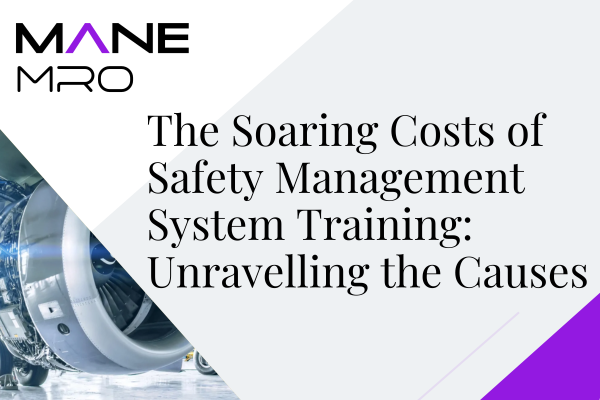
The Soaring Costs of Safety Management System Training: Unravelling the Causes
09 Sept, 20242minsIn recent years, the aviation industry has witnessed a substantial rise in the costs associa...

In recent years, the aviation industry has witnessed a substantial rise in the costs associated with Safety Management System (SMS) training. This increase has left many wondering about the underlying causes. Is it a consequence of the COVID-19 lockdowns, a lack of investment in trade schools, or the broader cost of living crisis? Let's delve into these factors and examine the role of legislation in driving up SMS training costs.
The Impact of COVID-19 Lockdowns
The global pandemic has undoubtedly played a significant role in reshaping the aviation industry, including its approach to safety training. During lockdowns, many airlines and maintenance organisations were forced to suspend or reduce operations, leading to furloughs and layoffs. As the industry recovers, there's an urgent need to retrain staff and bring them up to speed with current safety protocols.
Moreover, the pandemic has necessitated new safety procedures and protocols, requiring additional training modules. This expansion of training content, coupled with the need for social distancing measures in training environments, has inevitably increased costs.
Lack of Investment in Trade Schools
Another factor contributing to the rise in SMS training costs is the chronic underinvestment in aviation trade schools across Europe. This shortage of specialised educational facilities has created a skills gap in the industry. With fewer qualified instructors and limited training capacity, the cost of delivering high-quality SMS training has increased.
The European Union Aviation Safety Agency (EASA) has recognised this issue, but addressing it requires long-term planning and substantial investment. In the meantime, the scarcity of training resources continues to drive up costs.
The Cost of Living Crisis
The ongoing cost of living crisis, which has made headlines across Europe, is another significant factor. As inflation rates soar and energy prices spike, the overall cost of doing business has increased dramatically. Training providers have had to adjust their pricing to account for these increased operational costs, passing some of the burden onto trainees and their employers.
Legislative Drivers
Perhaps the most significant factor behind the increase in SMS training costs is the evolving regulatory landscape. The introduction of new legislation has placed additional demands on aviation organisations, particularly in the realm of safety management.
A key development is the EASA mandate requiring all maintenance organisations to implement an SMS by 2 December 2022. This regulation, which comes with a two-year transition period, has created a surge in demand for SMS training. Organisations are scrambling to ensure their staff are adequately trained to meet these new requirements.
As David Learmount reported from Wing Engineering's SMS Seminar and Workshop, "From 2 December 2022, European maintenance organisations must be operating an SMS, according to the European Union Aviation Safety Agency (EASA)." This deadline has put pressure on organisations to invest heavily in training, often at short notice.
The EASA regulations emphasise that compliance alone is not enough. As John Franklin, EASA's Head of Safety Promotion, explained, "Quality is about compliance. SMS is about performance." This shift in focus requires a more comprehensive and nuanced approach to training, which inevitably comes at a higher cost.
The Way Forward
While the increase in SMS training costs presents challenges for the aviation industry, it's important to recognise the long-term benefits of a robust safety culture. Organisations that invest in high-quality SMS training are likely to see returns in the form of improved safety performance, reduced incidents, and enhanced operational efficiency.
To address the cost issue, industry stakeholders might consider:
1. Collaborative approaches to training, sharing resources and best practices across organisations.
2. Investing in digital learning technologies to reduce the costs associated with in-person training.
3. Advocating for increased government support for aviation trade schools and training programs.
4. Developing in-house training capabilities to reduce reliance on external providers.
As the aviation industry continues to navigate these challenges, it's clear that SMS training will remain a critical priority. The key will be finding innovative ways to deliver high-quality training while managing costs effectively. By doing so, the industry can ensure it meets regulatory requirements and maintains the highest standards of safety, without compromising financial sustainability.

